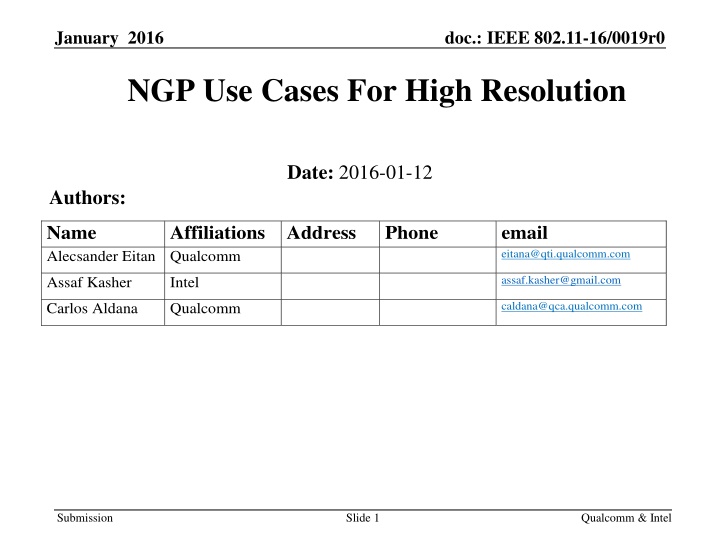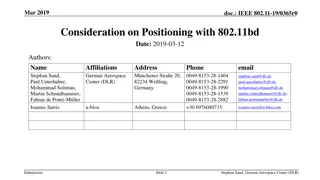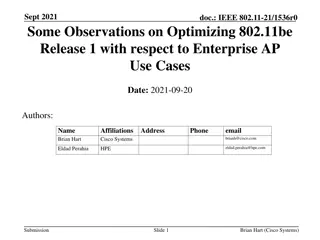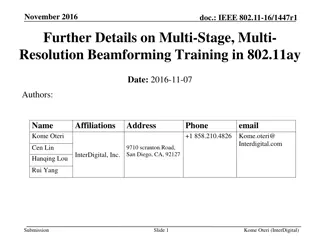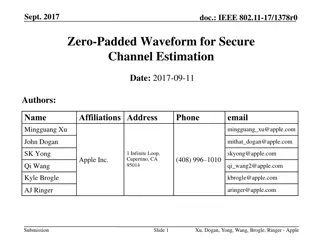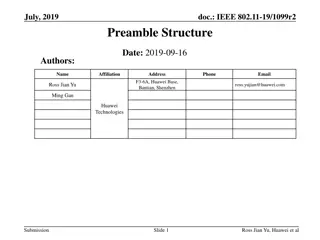IEEE 802.11-16/0019r0: Use Cases for High Resolution Location Estimation
This document, dated January 2016, outlines various use cases for high resolution location estimation within different environments such as stores, wearable devices with augmented reality features, and conference rooms. The use cases include scenarios like tracking user movements in a store for personalized promotions, precise augmentation in augmented reality devices, and dynamic setup determination in conference rooms. Each use case specifies the environmental context, expected accuracy, pointing angles, latency, refresh rate, and other relevant details.
Download Presentation

Please find below an Image/Link to download the presentation.
The content on the website is provided AS IS for your information and personal use only. It may not be sold, licensed, or shared on other websites without obtaining consent from the author.If you encounter any issues during the download, it is possible that the publisher has removed the file from their server.
You are allowed to download the files provided on this website for personal or commercial use, subject to the condition that they are used lawfully. All files are the property of their respective owners.
The content on the website is provided AS IS for your information and personal use only. It may not be sold, licensed, or shared on other websites without obtaining consent from the author.
E N D
Presentation Transcript
January 2016 doc.: IEEE 802.11-16/0019r0 NGP Use Cases For High Resolution Date: 2016-01-12 Authors: Name Alecsander Eitan Qualcomm Affiliations Address Phone email eitana@qti.qualcomm.com assaf.kasher@gmail.com Assaf Kasher Intel caldana@qca.qualcomm.com Carlos Aldana Qualcomm Submission Slide 1 Qualcomm & Intel
January 2016 doc.: IEEE 802.11-16/0019r0 Abstract This document contains several use cases for high resolution location estimation Location requirements are included with each use case to drive focus for the SIG Submission Slide 2 Qualcomm & Intel
January 2016 doc.: IEEE 802.11-16/0019r0 1. Nano Location in store User: Person with a smartphone which has the store app installed Environment: A store has APs for 802.11ad/ay coverage. The store has an AP on every isle Use case: 1. The user is going around in the store with their phone 2. Phone location indicates whether the user is moving, or whether he stopped in front of some product 3. The AP determines that the user is facing a specific product, and can offer promotional ad for competition (e.g. Pepsi instead of Coca-Cola machine) 4. Locate specific item (e.g. specific size/model in clothes department) 5. Power consumption profile: foreground for positioning determination, background for positioning services discovery. 6. Operating mode: AP2STA 7. Usage duration: 1 hour (10 minutes of foreground activity). Expected: Horizontal + vertical accuracy: <1 cm@90% Pointing angles (AZ, EL & Roll) accuracy: <10deg Latency: <10ms, for motion estimation, <100ms for static estimation Refresh Rate: 10-100Hz (same as GPS) Submission Slide 3 Qualcomm & Intel
January 2016 doc.: IEEE 802.11-16/0019r0 2. Augmented reality User: High-end wearable devices Environment: User wearing glasses with augmented reality features Use case: 1. The user is wandering around, wearing glass with augmented reality features 2. Exact location of the glasses is used for exact augmentation at each eye, per location. Each door which is looked at, is supplemented with an image showing behind the door scene 3. Power consumption profile: foreground for positioning determination 4. Operating mode: AP2STA Expected: Horizontal + vertical accuracy: <1 cm@90% Pointing angles (AZ, EL & Roll) accuracy: <2deg Latency: <10ms: augmentation data is required to be tagged with the exact location Refresh Rate: 0.5Hz-100Hz Submission Slide 4 Qualcomm & Intel
January 2016 doc.: IEEE 802.11-16/0019r0 3. Determine dynamic (conference) room setup User: Presenters in a conference room Environment: Conference room Use case: 1. Determine and track the physical setup of the Laptops and Displays in the room, and make it available to the users in the room. 2. Use the setup to move windows or other display elements between different laptops display and the room displays Expected: Horizontal + vertical accuracy: <20 cm@90% Pointing angles (AZ, EL & Roll) accuracy: < 20deg Latency: <0.5s: Refresh Rate: <2Hz Number of users up to 30 users, 3 APs Submission Slide 5 Qualcomm & Intel
January 2016 doc.: IEEE 802.11-16/0019r0 4. Proximity Detection User: Any 60GHz device Environment: Any environment Use case: 1. The user connects the device to the other device. 2. Distance between devices is measured. 3. If the distance is less than a predefined distance (10cm -100cm) special medium access rules may be applied For example relaxed CCA requirements 4. Operating mode: STA2STA or AP2STA Expected: Ranging accuracy: <5 cm@90% Pointing angles (AZ, EL & Roll) accuracy: <15deg (optional) Latency: <200ms: Refresh Rate: <2Hz Submission Slide 6 Qualcomm & Intel
January 2016 doc.: IEEE 802.11-16/0019r0 5. Determining Relative Location to Dock(s) User: Person with a Laptop/Tablet looking for docking Environment: Enterprise cubicle environment Use case: 1. The user is walking in an enterprise environment 2. User is presented with a list of docks, with the direction to each dock, and the distance. 3. Only docks within effective docking range are presented 4. If the user takes the laptop and walks away, the docking disconnects Expected: Horizontal + vertical accuracy: <30 cm@90% Pointing angles (AZ, EL & Roll) accuracy: <20deg Latency: <100ms Refresh Rate: 1-10Hz Mobility up to 1meter/sec Number of simultaneous users up to 12 users to 7 docking stations. Submission Slide 7 Qualcomm & Intel
January 2016 doc.: IEEE 802.11-16/0019r0 6. Wearable devices User: User during sport activity Environment: Wearable sensors on the person, connected to the mobile phone Use case: 1. Monitor movement-trajectory with location-tagging to avoid injury and improve performance 2. Monitor additional physical data such as heart-rate and electrical activity 3. Power consumption profile: foreground for positioning determination 4. Operating mode: AP2STA 5. Usage duration: 1-24 hour, low duty cycle activity 6. Up to 8 attached devices Expected: Horizontal + vertical accuracy: <1 cm@90% Pointing angles (AZ, EL & Roll) accuracy: <5deg Latency: <10ms: sensory data is required to be tagged with the exact location Refresh Rate: 0.5Hz-100Hz Note: Configuration of usage duration, refresh rate and battery are application specific and linked Submission Slide 8 Qualcomm & Intel
January 2016 doc.: IEEE 802.11-16/0019r0 7. Control consoles User: User controls TV, or a gaming console by using his phone, using location instead of gestures Environment: Living room Use case: 1. Using the mobile phone to control the TV menus, w/o using its screen 2. Using the mobile phone as control for gaming 3. Exact location of the phone is used for game control 4. Operating mode: AP2STA 1. Optional operating mode: STA2STA Expected: Horizontal + vertical accuracy: <1 cm@90% Pointing angles (AZ, EL & Roll) accuracy: <2deg Latency: <100ms: Refresh Rate: 10Hz-100Hz Submission Slide 9 Qualcomm & Intel
